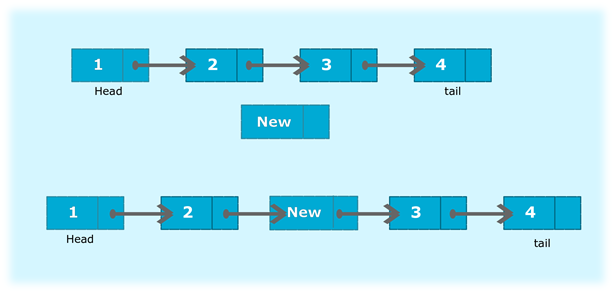In this program, we will create a singly linked list and add a new node at the middle of the list. To accomplish this task, we will calculate the size of the list and divide it by 2 to get the mid-point of the list where the new node needs to be inserted.

Consider the above diagram; node 1 represents the head of the original list. Let node New is the new node which needs to be added at the middle of the list. First, we calculate size which in this case is 4. So, to get the mid-point, we divide it by 2 and store it in a variable count. Node current will point to head. First, we iterate through the list till current points to the mid position. Define another node temp which point to node next to current. Insert the New node between current and temp
Algorithm
- Create a class Node which has two attributes: data and next. Next is a pointer to the next node in the list.
- Create another class InsertMid which has three attributes: head, tail, and size that keep tracks of a number of nodes present in the list.
- addNode() will add a new node to the list:
- Create a new node.
- It first checks, whether the head is equal to null which means the list is empty.
- If the list is empty, both head and tail will point to a newly added node.
- If the list is not empty, the new node will be added to end of the list such that tail's next will point to a newly added node. This new node will become the new tail of the list.
a. addInMid() will add a new node at the middle of the list:
- It first checks, whether the head is equal to null which means the list is empty.
- If the list is empty, both head and tail will point to a newly added node.
- If the list is not empty, then calculate the size of the list and divide it by 2 to get mid-point of the list.
- Define node current that will iterate through the list until current will point to the mid node.
- Define another node temp which will point to node next to current.
- The new node will be inserted after current and before temp such that current will point to the new node and the new node will point to temp.
a. display() will display the nodes present in the list:
- Define a node current which will initially point to the head of the list.
- Traverse through the list till current points to null.
- Display each node by making current to point to node next to it in each iteration.
Program:
Output: